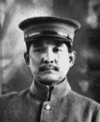Names
Copyright is reserved by wikipedia.com.
 Like
many other Chinese historical figures, Sun Yat-sen used several
names throughout his life, and he is known under several of these
names, which can be quite confusing for the Westerner. Names, which
are not taken lightly in China, are central to Chinese culture. This
reverence goes as far back as Confucius and his insistence on using
correct names. In addition to the names and aliases listed below,
Sun also used many other aliases while he was a revolutionary in
exile. According to one study, he used as many as thirty different
names. Like
many other Chinese historical figures, Sun Yat-sen used several
names throughout his life, and he is known under several of these
names, which can be quite confusing for the Westerner. Names, which
are not taken lightly in China, are central to Chinese culture. This
reverence goes as far back as Confucius and his insistence on using
correct names. In addition to the names and aliases listed below,
Sun also used many other aliases while he was a revolutionary in
exile. According to one study, he used as many as thirty different
names.The "real" name of Sun Yat-sen (the concept of real or original name is not as clear-cut in China as it is in the Western world, as will become obvious below), the name inscribed in the genealogical records of his family, is Sun Deming (孫德明). This "register name" is the name under which his extended relatives of the Sun family would have known him; and it was a name that was used on formal occasions, such as when he got married. In 1883, Sun was baptized as a Christian, and he started his studies in Hong Kong. On that occasion, he chose himself a pseudonym: Rixin (日新, lit. renew oneself daily). Later, his professor of Chinese literature changed this pseudonym into Yixian (逸仙). Unlike in Standard Mandarin, pronunciation of both pseudonyms are similar to Yat-sen in the local Cantonese. This was the name that he used in his frequent contacts with Westerners which became his most often used name in the West. However, in the Chinese world, almost nobody uses the Mandarin version Sun Yixian, nor the Cantonese version Sun Yat-sen. In 1897, Sun arrived in Japan. Desiring to remain hidden from Japanese authorities, he renamed himself Nakayama Shō (中山樵). After his return to China in 1911, the alias Nakayama was transliterated into Zhongshan. Today, the overwhelming majority of Chinese people know Sun under the name Sun Zhongshan. Often it is shortened to Zhongshan only (as is usually done for Chinese names to show respect), and inside China one can find many instances of Zhongshan Avenue, Zhongshan Park, etc. Another "official" name is Sun Wen (孫文), the "school name" used by Sun Yat-sen when attending school. This is the way he signed his name, especially after the establishment of the Republic of China in 1912. All official documents executed after this date were signed Sun Wen. In 1940, the Kuomintang party officially conferred on the late Sun the title Guofu (國父, meaning "National Father"), and this title is still frequently used in Taiwan and Hong Kong. In mainland China, the title "Forerunner of the Revolution" (革命先行者) is sometimes used instead. |
Home / Biography / History / Names / Gallery / Links / Contact